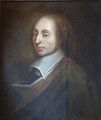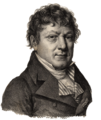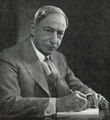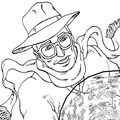Template:Selected anniversaries/August 19: Difference between revisions
No edit summary |
No edit summary |
||
| (35 intermediate revisions by the same user not shown) | |||
| Line 1: | Line 1: | ||
<gallery> | <gallery> | ||
|| | ||1580: Pierre Vernier born ... was a French mathematician and instrument inventor. He was inventor and eponym of the vernier scale used in measuring devices. Pic: device. | ||
|| | ||1612: The "Samlesbury witches", three women from the Lancashire village of Samlesbury, England, are put on trial, accused of practicing witchcraft, one of the most famous witch trials in British history. Pics. | ||
||1646: John Flamsteed born ... astronomer and academic. Pic. | |||
|| | File:Blaise Pascal.jpg|link=Blaise Pascal (nonfiction)|1662: Mathematician, physicist, inventor, writer, and Christian philosopher [[Blaise Pascal (nonfiction)|Blaise Pascal]] dies. Pacal did pioneering work on calculating machines. | ||
||1753 | ||1692: Salem witch trials: In Salem, Province of Massachusetts Bay, five people, one woman and four men, including a clergyman, are executed after being convicted of witchcraft. | ||
||1711: Soldier and industrialist Gabriel de Solages born. After serving in Italy, Germany and Bohemia he began exploiting coal mines on the family property near Carmaux in the Tarn department of southern France. To make use of surplus coal he opened a glass bottle factory and an iron works, and also opened a factory to make shipbuilding supplies. Pic. | |||
||1736: Erland Samuel Bring born ... mathematician. Pic. | |||
||1745: Johan Gottlieb Gahn born ... chemist and metallurgist who discovered manganese in 1774. Pic. | |||
||1753: Johann Balthasar Neumann dies ... engineer and architect, designed Basilica of the Fourteen Holy Helpers. Pic search. | |||
File:Jean-Étienne Montucla.jpg|link=Jean-Étienne Montucla (nonfiction)|1758: [[Jean-Étienne Montucla (nonfiction)|Jean-Étienne Montucla]] received the censor's approbation for his ''Histoire des mathematiques'', which is justly famous as a history of the mathematical sciences. | |||
||1765: Baron Axel Fredrik Cronstedt dies ... mineralogist and chemist who discovered nickel in 1751 as a mining expert with the Bureau of Mines. Cronstedt is one of the founders of modern mineralogy. Pic. | |||
||1785: Seth Thomas born ... clock manufacturer who was one of the pioneers in the mass production of clocks. After working with Eli Terry and Silas Hoadley in firm of Terry, Thomas & Hoadley, which manufactured clocks by mass production methods (1807), Thomas founded a clock factory of his own at Plymouth Hollow, Conn. (1812). He was not an inventive genius, but he was an excellent mechanic and a keen business man. Two years later he paid Terry for the rights to manufacture the latter's popular shelf clock. Shortly, he was selling as many clocks as Terry. As his business developed Thomas built a mill for rolling brass and making wire at Plymouth Hollow, and operated it in conjunction with the clock factory. Finally, he organized the Seth Thomas Clock Co. (1853). Pic. | |||
||1790: Edward John Dent born ... clockmaker and inventor whose chronometers were noted for high accuracy. His patents in this field included compasses for navigation and surveying. He experimented with springs made of steel, gold and glass, and devices for counteracting the effects of temperature change upon timepiece mechanisms. As clockmaker to Queen Victoria, he was commissioned to build the Great Clock for the clock tower of the Houses of Parliament (known as Big Ben, although that is actually the nickname of its hour bell) which he began in the year he died. His son, Frederick Dent, completed the work the following year and it was installed in the tower in 1859. It continues to be recognized for its great accuracy of 4 seconds in a year. Pic. | |||
||1808: James Nasmyth born ... engineer who invented the steam-hammer (24 Nov 1839) which was patented in Britain on 9 Jun 1842 (No. 9382). In his early career, Nasmyth improved the design of machine tools. Power hammers had previously been driven by steam, but Nasmyth designed his steam-hammer with more precision and control. The steam functioned to lift the hammer which then dropped by gravity, and repeated the cycle. Nasmyth adapted the idea to make a steam pile-driver. With later improvements, the steam-hammer enabled forging very large guns for the British navy. He became wealthy and in 1856 was able to retire at the age of 48. After retirement, Nasmyth pursued his hobby of astronomy, in which he published minor works. Pic. | |||
File:Jean Baptiste Joseph Delambre.png|link=Jean Baptiste Joseph Delambre (nonfiction)|1822: Mathematician and astronomer [[Jean Baptiste Joseph Delambre (nonfiction)|Jean Baptiste Joseph Delambre]] dies. He was one of the first astronomers to derive astronomical equations from analytical formulas. | File:Jean Baptiste Joseph Delambre.png|link=Jean Baptiste Joseph Delambre (nonfiction)|1822: Mathematician and astronomer [[Jean Baptiste Joseph Delambre (nonfiction)|Jean Baptiste Joseph Delambre]] dies. He was one of the first astronomers to derive astronomical equations from analytical formulas. | ||
||1830: Julius Lothar Meyer born ... chemist who discovered the Periodic Law, independently of Dmitry Mendeleyev, at about the same time (1869). However, he did not develop the periodic classification of the chemical elements as thoroughly as Mendeleyev. Meyer trained originally in medicine and chemistry. He examined the effect of carbon monoxide on blood. In 1879, Meyer compared atomic volume to atomic weight. Plotted on a graph, the curve showed the periodicity of the elements. He also established the concept of valency by indicating that a given element combined with a characteristic number of hydrogen atoms, and coined the terms like univalent, bivalent, and trivalent, based on that number. Pic. | |||
||1839: Louis Daguerre announces the invention of the daguerreotype photographic process, the first process to allow an image to be chemically fixed as a permanent picture. On 7 Jan 1839 an announcement was made of the discovery, but details were not divulged until 19 Aug, when the process was announced publicly, and the French government having bought the rights to the process from him, freely gave them to the world. However, this process had also been patented in England and Wales on 14 Aug 1839, only five days previously. Pic. | |||
||1854: The First Sioux War begins when United States Army soldiers kill Lakota chief Conquering Bear and in return are massacred. Pics. | |||
||1856: Charles Frédéric Gerhardt dies ... chemist. Pic. | |||
||1865: Hantaro Nagaoka born ... physicist and a pioneer of Japanese physics during the Meiji period. Pic. | |||
||1871: Orville Wright, American engineer and pilot, co-founded the Wright Company. pic. | |||
||1876: George Smith dies ... archaeologist and Assyriologist who translated Babylonian cuneiform tablets (1872) describing a great deluge, part of the Gilgamesh epic, and akin to that found in Genesis. Smith, as an apprentice banknote engraver since age 14, spent much of his own time teaching himself how to decipher cuneiform, by studying inscriptions available at the British Museum. His skill was recognized, and he worked for the British Museum from 1867. Smith engaged in fieldwork in 1873 at Nineveh (Kuyunjik) finding more tablet fragments of the flood story, and others on the Babylonian dynasties. He published his work in The Chaldean Account of Genesis (1876). He died at age 36 of a fever while excavating more of Assurbanipal's library. Pic. | |||
||1883: Leonid Kulik born ... minerologist who conducted the first scientific expedition (for which records survive) to study the Tungusta meteor impact site. He began in 1927, and continued to work on the investigation until, while fighting for his country in WW II, he was captured and died of typhus in a Nazi prison camp. Pic. | |||
|| | ||1887: Alvan Clark dies ... astronomer whose family became the first significant manufacturers of astronomical instruments in the U.S. His company manufactured apparatus for most American observatories of the era, including Lick and Pulkovo, and others in Europe. In 1862, while testing a telescope, Clark discovered the companion star to Sirius, which had previously been predicted but until then never sighted. The 18½-in objective telescope he used was subsequently delivered to the Dearborn Observatory, Chicago. His sons, Alvan Graham Clark and George Bassett Clark, continued the business. The unexcelled 40-in refractor telescopes for the 40-in Yerkes observatory was made by Alvan Graham Clark. Pic. | ||
|| | ||1887: Dmitri Ivanovich Mendeleev uses a balloon to ascend above the cloud cover to an altitude of 11,500 feet (3.5 km) to observe an eclipse in Russia. He made the solo ascent above Klin without any prior experience. While his family was rather concerned, he paid no attention to controlling the balloon until after he had completed his observations, at which time he worked out how to land it. Mendeleev is the Russian chemist known for the ordering of the Periodic Table of the Elements. Yet, he was interested in many fields of science. He studied problems associated with Russia's natural resources, such as coal, salt, metals, and the petroleum industry. In 1876, he visited the U.S. to observe the Pennsylvania oil fields. | ||
||Robert Brainard Corey | ||1888: Erik Edlund dies ... physicist. His scientific research was confined chiefly to the theory of electricity. He helped secure the introduction of weather stations to Sweden. | ||
||1891: Milton La Salle Humason born ... astronomer. He became known as a meticulous observer, obtaining photographs and difficult spectrograms of faint galaxies. His observations played a major role in the development of physical cosmology. Pic search. | |||
||1897: Robert Brainard Corey born ... biochemist, mostly known for his role in discovery of the α-helix and the β-sheet with Linus Pauling. Pic search. | |||
File:Philo T Farnsworth.jpg|link=Philo Farnsworth (nonfiction)|1906: Inventor [[Philo Farnsworth (nonfiction)|Philo Farnsworth]] born. He will make many crucial contributions to the early development of all-electronic television. | File:Philo T Farnsworth.jpg|link=Philo Farnsworth (nonfiction)|1906: Inventor [[Philo Farnsworth (nonfiction)|Philo Farnsworth]] born. He will make many crucial contributions to the early development of all-electronic television. | ||
||1924 | ||1909: Joseph Gilbert Hoffman born ... physicist and biophysicist who brought atomic isotopes into the battle against cancer. During WW II, he developed a radio proximity fuse and later was a health-physics scientist with "Manhattan Project." Hoffman studied nine accident victims of radiation disease at Los Alamos in Aug 1945 and May 1946. This research revealed for the first time that atoms of living human tissue could be transformed into radioactive atoms. He recognized "a completely new approach to studying the metabolism of atoms in living tissue and a new way of probing the complicated system of gene cells that determine heredity," and such knowledge was indispensable to understanding the mysteries of cancer research in which he engaged for the rest of his life. Pic search. | ||
File:John Hadji Argyris.jpg|link=John Argyris (nonfiction)|1913: Computer scientist, engineer, and academic [[John Argyris (nonfiction)|John Argyris]] born. A pioneer of computer applications in science and engineering, Argyris will be among the creators of the finite element method. | |||
File:Vilfredo Pareto 1870s.jpg|link=Vilfredo Pareto (nonfiction)|1923: Engineer, sociologist, economist, political scientist, and philosopher [[Vilfredo Pareto (nonfiction)|Vilfredo Pareto]] dies. He applied mathematics to economic analysis, asserting that the distribution of incomes and wealth in society is not random and that a consistent pattern appears throughout history, in all parts of the world and in all societies. | |||
||1923: Edgar F. Codd born ... computer scientist and mathematician who laid the theoretical foundation for relational databases, for storing and retrieving information in computer records. He also contributed knowledge in the area of cellular automata. Pic. | |||
||1924: Willard Boyle born ... physicist and academic, Nobel Prize laureate ... pioneer in the field of laser technology and co-inventor of the charge-coupled device. Pic. | |||
||1926: George Daniels born ... horologist who was considered to be the best in the world during his lifetime. He was one of the few modern watchmakers who built complete watches by hand (including the case and dial). But it was his creation of the coaxial escapement for which he is most remembered. The movement, which removed the need to add a lubricant, has been used by Omega in their highest-grade watches since 1999. Pic search. | |||
||1931: Aristides Agramonte y Simoni dies ... pathologist and bacteriologist who was a member of the Reed Yellow Fever Board of the U.S. Army that discovered (1901) the role of the mosquito in the transmission of yellow fever. In May 1898, he was appointed Acting Assistant Surgeon in the U.S. Army. Agramonte had acquired immunity to yellow fever from a mild childhood case in Cuba before emigrating to the U.S., which was an advantage when he was chosen by the Surgeon-General to study the yellow fever outbreak in General Shafter's army in Cuba. There Agramonte performed autopsies in order to determine the causative agent of the disease. After additional work in Cuba, in May 1900, Agramonte was appointmented to Walter Reed's Yellow Fever Commission. Pic. | |||
||1939: Alan Baker born ... mathematician, known for his work on effective methods in number theory, in particular those arising from transcendental number theory. Pic. | |||
||1940: First flight of the B-25 Mitchell medium bomber. | |||
||1943: The Quebec Agreement signed ... was an agreement between the United Kingdom and the United States outlining the terms for the coordinated development of the science and engineering related to nuclear energy, and, specifically nuclear weapons. It was signed by Winston Churchill and Franklin D. Roosevelt on 19 August 1943, during World War II, at the Quadrant Conference in Quebec City, Quebec, Canada. Pic (to exploit). | |||
||1947: Paul Callaghan born ... physicist and academic. Callaghan's research group specialized in developing NMR methodologies for the study of molecular dynamics and molecular organisation in complex fluids, soft matter and porous materials. Pic search. | |||
||1947: The first full synthesis route for vitamin A was found by Dutch chemists, Jozef Ferdinand Arens and David Adriaan van Dorp. Later in 1947, a team headed by O. Isler also synthesized vitamin A using a method more suitable to produce commerical quantities. | |||
||1950: Giovanni Giorgi dies ... physicist and engineer. Pic. | |||
||1953: The CIA and MI6 help to overthrow the government of Mohammad Mosaddegh in Iran and reinstate the Shah Mohammad Reza Pahlavi. | |||
||1957: Carl-Gustaf Rossby dies ... meteorologist who first explained the large-scale motions of the atmosphere in terms of fluid mechanics. His work contributed to developing meteorology as a science. Rossby first theorized about the existence of the jet stream in 1939, and that it governs the easterly movement of most weather. U.S. Army Air Corps pilots flying B-29 bombing missions across the Pacific Ocean during World War II proved the jet stream's existence. The pilots found that when they flew from east to west, they experienced slower arrival times and fuel shortage problems. When flying from west to east, however, they found the opposite to be true. Rossby created mathematical models (Rossby equations) for computerized weather prediction (1950). Pic search. | |||
||1960: In Moscow, Russia, Soviet Union, downed American U-2 pilot Francis Gary Powers is sentenced to ten years imprisonment by the Soviet Union for espionage. | |||
||1960: Sputnik program: Korabl-Sputnik 2: The Soviet Union launches the satellite with the dogs Belka and Strelka, 40 mice, two rats and a variety of plants. | |||
||1960, the first commercial atomic energy reactor, and the third in the U.S., achieved a self-sustaining nuclear reaction. It began producing power for distribution on 10 Nov 1960. This was the $57 million Yankee Atomic Electric Company's plant at Rowe, Mass., on the Deerfield River. The pressurized light-water reactor produced 125,000 kilowatts of electricity. The company was formed by twelve New England utility companies which signed a contract with the Westinghouse Corporation as the principal contractor. It was permanently shut down on 26 Feb 1992, due to reactor vessel embrittlement, after more than 31 years of service. Decommissioning began in 1993. | |||
||1964: Hans Peter Luhn dies ... researcher in the field of computer science, and, Library & Information Science for IBM, and creator of the Luhn algorithm, KWIC (Key Words In Context) indexing, and Selective dissemination of information ("SDI"). Pic search. | |||
|| | ||1964: Syncom 3, the first geostationary communication satellite, is launched. | ||
|| | ||1967: Hugo Gernsback dies ... inventor (80 patents) and publisher who was largely responsible for the establishment of science fiction as an independent literary form. Hugo founded radio station WRNY, was involved in the first television broadcasts and is considered a pioneer in amateur radio. In 1926, as owner of a magazine, Modern Electrics, he filled a blank spot in his publication by dashing off the first chapter of a series called "Ralph 124C 41+." "Ralph" was an amazing success. The 12-part story was filled with all kinds of wild inventions unheard of in 1926, including television (he is credited with introducing this word), fluorescent lighting, juke boxes, solar energy, television, microfilm, vending machines, and a device we now call radar. Pic. | ||
|| | File:Hugo Gernsback by Bachrach.jpg|link=Hugo Gernsback (nonfiction)|1967: Inventor, writer, editor, and publisher [[Hugo Gernsback (nonfiction)|Hugo Gernsback]] dies. He published the first science fiction magazine, and had a profound influence on the development of science fiction. | ||
|| | ||1968: George Gamow dies ... nuclear physicist, cosmologist and writer who was one of the foremost advocates of the big-bang theory, which describes the origin of the universe as a colossal explosion that took place billions of years ago. In 1954, he expanded his interests into biochemistry and his work on deoxyribonucleic acid (DNA) made a basic contribution to modern genetic theory. Pic. | ||
|| | ||1982: Manali Kallat Vainu Bappu dies ... astronomer. In 1957, he discovered the Wilson-Bappu effect jointly with American astronomer Olin Chaddock Wilson. He is regarded as the father of modern Indian astronomy. Pic. | ||
|| | ||1983: Octav Onicescu dies ... mathematician, member of the Romanian Academy, and founder of the Romanian school of probability theory and statistics. Pic. | ||
File:Dard Hunter, Glyph Warden detail.jpg|link=Niles Cartouchian (1900s)|1993: | File:Dard Hunter, Glyph Warden detail.jpg|link=Niles Cartouchian (1900s)|1993: Actor-cryptographer [[Niles Cartouchian]] confirms that he personally designed the computational security protocols featured in the action-adventure film ''[[Dard Hunter, Glyph Warden]]''. | ||
File:Linus Pauling.jpg|link=Linus Pauling (nonfiction)|1994: Chemist, biochemist, peace activist, author, and educator [[Linus Pauling (nonfiction)|Linus Pauling]] dies. | File:Linus Pauling.jpg|link=Linus Pauling (nonfiction)|1994: Chemist, biochemist, peace activist, author, and educator [[Linus Pauling (nonfiction)|Linus Pauling]] dies. | ||
|File: | ||1998: Yuri Andreevich Yappa dies ... theoretical physicist. He is known for publications on particle physics, quantum field theory, General Relativity, philosophy of science, and for his graduate texts on classical electrodynamics and theory of spinors. Pic. | ||
||2013: Kenneth N. Stevens dies ... engineer and academic. Stevens was head of the Speech Communication Group in MIT's Research Laboratory of Electronics (RLE), and was one of the world's leading scientists in acoustic phonetics. Pic. | |||
||2014: Walter Thirring dies ... physicist after whom the Thirring model in quantum field theory is named. | |||
File:Giant Red Ball in Toledo Ohio.jpg|link=Toledo giant red ball incident (nonfiction)|2015: A [[Toledo giant red ball incident (nonfiction)|giant red ball breaks loose from an art installation and rolls down the street]] in Toledo, Ohio. | |||
</gallery> | </gallery> | ||
Latest revision as of 12:12, 7 February 2022
1662: Mathematician, physicist, inventor, writer, and Christian philosopher Blaise Pascal dies. Pacal did pioneering work on calculating machines.
1758: Jean-Étienne Montucla received the censor's approbation for his Histoire des mathematiques, which is justly famous as a history of the mathematical sciences.
1822: Mathematician and astronomer Jean Baptiste Joseph Delambre dies. He was one of the first astronomers to derive astronomical equations from analytical formulas.
1906: Inventor Philo Farnsworth born. He will make many crucial contributions to the early development of all-electronic television.
1913: Computer scientist, engineer, and academic John Argyris born. A pioneer of computer applications in science and engineering, Argyris will be among the creators of the finite element method.
1923: Engineer, sociologist, economist, political scientist, and philosopher Vilfredo Pareto dies. He applied mathematics to economic analysis, asserting that the distribution of incomes and wealth in society is not random and that a consistent pattern appears throughout history, in all parts of the world and in all societies.
1967: Inventor, writer, editor, and publisher Hugo Gernsback dies. He published the first science fiction magazine, and had a profound influence on the development of science fiction.
1993: Actor-cryptographer Niles Cartouchian confirms that he personally designed the computational security protocols featured in the action-adventure film Dard Hunter, Glyph Warden.
1994: Chemist, biochemist, peace activist, author, and educator Linus Pauling dies.
2015: A giant red ball breaks loose from an art installation and rolls down the street in Toledo, Ohio.









